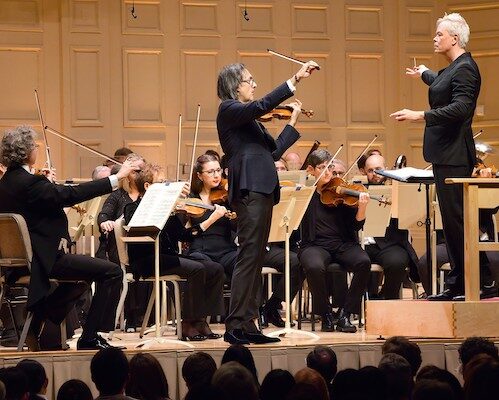Kavakos’s impassioned Berg highlights BSO program led by Lintu

Leonidas Kavakos performed Berg’s Violin Concerto with Hannu Lintu conducting the Boston Symphony Orchestra Thursday night at Symphony Hall. Photo: Hilary Scott
“The people who you think are radicals might really be conservatives,” the composer Morton Feldman once offered. “The people who you think are conservative might really be radical.”
In the event, Feldman was talking about the Finnish composer Jean Sibelius. But his sentiment seemed to apply equally well to the works by Peter Lieberson, Alban Berg, and Robert Schumann that the Boston Symphony Orchestra featured Thursday night.
It also, somewhat more surprisingly, fit with conductor Hannu Lintu, who returned to the Symphony Hall podium for the first time since his visit just before the pandemic shut down concert life in March 2020. The Finnish maestro is the picture of Modernist, urban cool. Yet the performances he drew from the orchestra on Thursday often evinced a rhythmic vigor, tonal purity, and lack of sentimentality that was downright Classical.
This was most apparent in the evening’s reading of Berg’s Violin Concerto. Composed in 1935, the half-hour work is as much a memorial to Alma Mahler’s 18-year-old daughter, Manon Gropius, as it is to the composer himself, who died of blood poisoning four months before its April 1936 premiere.
Berg’s harmonic (and, frequently enough, melodic) sensibilities were firmly entrenched in the early 20th century. Yet his music regularly looked back, formally and spiritually, to the 18th and 19th epochs, and certainly does so in this concerto.
Though the writing generally eschews the flamboyant virtuosic excesses of the Romantics, the music’s expressive immediacy is rooted in its debts to the rhetoric of Beethoven and Brahms. Bach is also an inspiration—Berg’s haunting harmonization of the chorale “Es ist genug” is, famously, the crux on which the score’s dramatic and emotional axes pivot.
Lintu drew quotations of that melody from the BSO’s woodwind section that, for warmth, blend, and balance, simply glowed Thursday night. Indeed, so pristinely did the conductor illuminate the finale’s several strands of the chorale theme that the concerto’s second movement took on a rare structural focus.
The performance also managed this due to the radiant playing of violinist Leonidas Kavakos, whose account of the solo part was consistently impassioned and intense. Though at times in the first movement he seemed to be in competition with the orchestra’s volume level, the Greek violinist’s delivery of its Carinthian folk song nevertheless danced delicately.
Meantime, the toughness with which Kavakos imbued the finale’s double- and triple-stops was as gripping as his take on the score’s gently soaring closing bars was touching. Afterwards, came an unexpectedly substantial Bach encore in the form of the Sarabande and Double from the Partita No. 1 in B minor.
If the Technicolor Violin Concerto was the night’s most substantial effort, it didn’t claim the evening’s monopoly on instrumental color. Rather, that honor was shared with Lieberson’s Drala.
Commissioned by the BSO and premiered in 1986, Thursday marked the first time the orchestra has presented this kaleidoscopic piece in nearly forty years. On the merits of the evening’s reading, that’s both surprising and to be expected.
Drala offers striking moments, to be sure, like the burbling woodwind figures, harp glissandos, and bittersweet lyrical turns of the “Introduction.” And there are exciting spots, like the concluding “Raising Windhorse,” with its slashing riffs and blazing percussion free-for-alls.
At the same time, Drala, which is a symphonic exploration of the Buddhistic concept of the individual overcoming opposition to “become…perceptive of all life, energy, and matter,” sometimes drags. “Offerings and Praises” seemed to meander despite a series of beautifully dovetailed solos inaugurated by BSO principal cellist Blaise Déjardin. Nor was the score’s larger impression enhanced by moments (like some in the bright toned “Gathering”) of textural blurriness and imprecision.
In the last, at least, Drala shared something in common with Schumann’s Symphony No. 4 (though numbered as his last, the Fourth was the second symphony Schumann completed; yesterday’s performance was of its 1851 revision). One of the 19th-century visionary’s most compact essays, the effort deals inventively with issues of thematic transformation and through-composition, all four movements proceeding one to the next without pause.
Perhaps yesterday’s reading suffered from a lack of rehearsal time owing to the demands of the night’s first half. How else to explain its moments of spotty ensemble, fuzzy balances, and otherwise general blandness? Missing over the first three movements were any real sense of mystery, intensity, or surprise.
Thankfully, all three of those qualities showed up in force in the finale, which was as fresh, shapely, and conversational (especially in its developmental episodes) as one wished the work’s first twenty minutes had been. Even if the coda didn’t quite hit a true Presto, it sounded marvelously alive—and as radically in-your-face as Schumann, at his best, ought to.
The program will be repeated (sans Drala) at 8 p.m. Friday and (in full) at 8 p.m. Saturday at Symphony Hall. bso.org
Posted in Performances



